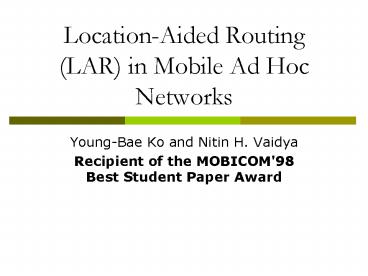Location-Aided Routing (LAR) in Mobile Ad Hoc Networks - PowerPoint PPT Presentation
1 / 21
Title:
Location-Aided Routing (LAR) in Mobile Ad Hoc Networks
Description:
Using location information to reduce the number of nodes to whom route request is propagated. ... S knows that node D was at location L at time t0, and that the ... – PowerPoint PPT presentation
Number of Views:217
Avg rating:3.0/5.0
Title: Location-Aided Routing (LAR) in Mobile Ad Hoc Networks
1
Location-Aided Routing (LAR) in Mobile Ad Hoc
Networks
- Young-Bae Ko and Nitin H. Vaidya
- Recipient of the MOBICOM'98 Best Student Paper
Award
2
Problem
D
t0
t1
C
C
C
A
X
S
D
X
S
D
X
S
B
E
3
Route Discovery Using Flooding
route request
C
route reply
A
X
S
D
B
E
4
Location-Aided Routing
- Main Idea
- Using location information to reduce the number
of nodes to whom route request is propagated. - Location-aided route discovery based on limited
flooding
5
Location Information
- Consider a node S that needs to find a route to
node D. - Assumption
- each host in the ad hoc network knows its current
location precisely (location error considered in
one of their simulations) - node S knows that node D was at location L at
time t0, and that the current time is t1 - Location services in ad hoc networks, refer to
- A survey on position-based routing in mobile ad
hoc networks, M. Mauve, J. Widmer, and H.
Hartenstein, IEEE Network, Vol. 15 No. 6, 2001.
6
Expected Zone
expected zone of D ---- the region that node S
expects to contain node D at time t1, only an
estimate made by node S
7
Request Zone
- LARs limited flooding
- A node forwards a route request only if it
belongs to the request zone - The request zone should include
- expected zone
- other regions around the expected zone
- No guarantee that a path can be found consisting
only of the hosts in a chosen request zone. - timeout
- expanded request zone
- Trade-off between
- latency of route determination
- the message overhead
8
Membership of Request Zone
- How a node determine if it is in the request zone
for a particular route request
- LAR scheme 1
- LAR scheme 2
9
LAR Scheme 1
10
LAR Scheme 2
S knows the location (Xd, Yd) of node D at time
t0 Node S calculates its distance from location
(Xd, Yd) DISTs
Node I receives the route request, calculates its
distance from location (Xd, Yd) DISTi For some
parameter d, If DISTs d DISTi, node I
replaces DISKs by DISKi and forwards the request
to its neighbors otherwise discards the route
request
11
Error in Location Estimate
- Let e denote the maximum error in the coordinates
estimated by a node. - Modified LAR scheme 1
ev(t1-t0)
Expected Zone
D (Xd, Yd)
12
Evaluation
- Comparing
- Flooding
- LAR scheme 1
- LAR scheme 2
- Study Cases on Varying
- number of nodes in the network
- 15, 30, 50 nodes
- transmission range of each node
- 200, 300, 400, or 500 units
- moving speed
- consider average speed (v) in range 1.5 to 32.5
units/sec
13
Definition of Evaluation Metric
- DP data packets
- data packets received by the destination
- RP routing packets
- routing related packets (i.e., route request,
route reply and route error) received by various
nodes - Routing packets per Data packet
14
Varying the Average Speed
15
Varying the Transmission Range
16
Varying the Number of Nodes
17
Routing Packets per Route Discovery
18
Impact of Location Error (I)
19
Impact of Location Error (II)
20
Variations and Optimizations
- Alternative Definitions of Request Zone
- increasing the request zone gradually?
- Adaptation of Request Zone
- Propagation of Location and Speed Information
- Local Search
21
- More Recent Work on Forwarding Strategy Work on
Location Service - see A survey on position-based routing in mobile
ad hoc networks, M. Mauve, J. Widmer, and H.
Hartenstein, IEEE Network, Vol. 15 No. 6, 2001.































